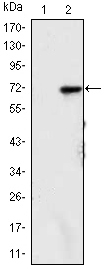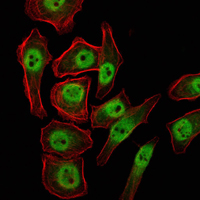JMJD2A Monoclonal Antibody
- Catalog No.:YM0389
- Applications:WB;IHC;IF;ELISA
- Reactivity:Human
- Target:
- JMJD2A
- Gene Name:
- KDM4A
- Protein Name:
- Lysine-specific demethylase 4A
- Human Gene Id:
- 9682
- Human Swiss Prot No:
- O75164
- Mouse Swiss Prot No:
- Q8BW72
- Immunogen:
- Purified recombinant fragment of human JMJD2A expressed in E. Coli.
- Specificity:
- JMJD2A Monoclonal Antibody detects endogenous levels of JMJD2A protein.
- Formulation:
- Liquid in PBS containing 50% glycerol, 0.5% BSA and 0.02% sodium azide.
- Source:
- Monoclonal, Mouse
- Dilution:
- WB 1:500 - 1:2000. IHC 1:200 - 1:1000. IF 1:200 - 1:1000. ELISA: 1:10000. Not yet tested in other applications.
- Purification:
- Affinity purification
- Storage Stability:
- -15°C to -25°C/1 year(Do not lower than -25°C)
- Other Name:
- KDM4A;JHDM3A;JMJD2;JMJD2A;KIAA0677;Lysine-specific demethylase 4A;JmjC domain-containing histone demethylation protein 3A;Jumonji domain-containing protein 2A
- Molecular Weight(Da):
- 121kD
- References:
- 1. Genome Res. 2004 Sep;14(9):1711-8.
2. Nat Methods. 2005 Aug;2(8):591-8.
3. Cell. 2006 May 19;125(4):691-702.
- Background:
- This gene is a member of the Jumonji domain 2 (JMJD2) family and encodes a protein containing a JmjN domain, a JmjC domain, a JD2H domain, two TUDOR domains, and two PHD-type zinc fingers. This nuclear protein functions as a trimethylation-specific demethylase, converting specific trimethylated histone residues to the dimethylated form, and as a transcriptional repressor. [provided by RefSeq, Apr 2009],
- Function:
- cofactor:Binds 1 Fe(2+) ion per subunit.,domain:The 2 Tudor domains recognize and bind methylated histone H3 'Lys-4' residue. Double Tudor domain has an interdigitated structure and the unusual fold is required for its ability to bind methylated histone tails. Trimethylated H3 'Lys-4' is bound in a cage of 3 aromatic residues, 2 of which are from the Tudor domain 2, while the binding specificity is determined by side-chain interactions involving residues from the Tudor domain 1. The Tudor domains are able to bind trimethylated histone H3 'Lys-4', trimethylated histone H3 'Lys-9', di- and trimethylated H4 'Lys-20'.,function:Histone demethylase that specifically demethylates 'Lys-9' and 'Lys-36' residues of histone H3, thereby playing a central role in histone code. Does not demethylate histone H3 'Lys-4', H3 'Lys-27' nor H4 'Lys-20'. Demethylates trimethylated H3 'Lys-9' and H3 'Lys-36' r
- Subcellular Location:
- Nucleus .
- Expression:
- Ubiquitous.
- June 19-2018
- WESTERN IMMUNOBLOTTING PROTOCOL
- June 19-2018
- IMMUNOHISTOCHEMISTRY-PARAFFIN PROTOCOL
- June 19-2018
- IMMUNOFLUORESCENCE PROTOCOL
- September 08-2020
- FLOW-CYTOMEYRT-PROTOCOL
- May 20-2022
- Cell-Based ELISA│解您多样本WB检测之困扰
- July 13-2018
- CELL-BASED-ELISA-PROTOCOL-FOR-ACETYL-PROTEIN
- July 13-2018
- CELL-BASED-ELISA-PROTOCOL-FOR-PHOSPHO-PROTEIN
- July 13-2018
- Antibody-FAQs
- Products Images

- Western Blot analysis using JMJD2A Monoclonal Antibody against HEK293 (1) and JMJD2A-hIgGFc transfected HEK293 (2) cell lysate.

- Immunohistochemistry analysis of paraffin-embedded colon cancer tissues (left) and human larynx cancer tissues (right) with DAB staining using JMJD2A Monoclonal Antibody.

- Immunofluorescence analysis of NTERA-2 cells using JMJD2A Monoclonal Antibody (green). Red: Actin filaments have been labeled with Alexa Fluor-555 phalloidin.



